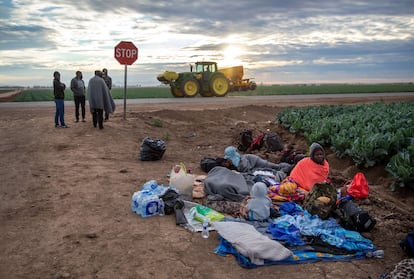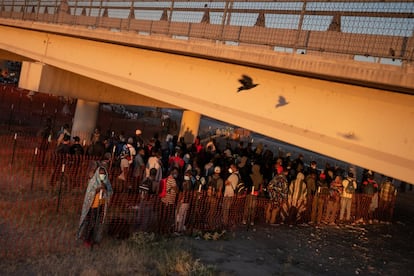No, they’re not eating dogs or cats: The real situation of Haitian migrants in the United States
In 2023, more than 731,000 Haitians were living in the diaspora in the U.S. According to NGOs, 227 deportation flights were made to the country between 2021 and 2022


The latest furor in the United States is over whether Haitian migrants are eating pets or not. This claim made by Donald Trump at the presidential debate on Tuesday — which was watched by more than 67 million people — was all it took for analysts to rush to check the facts, the media to flood Springfield authorities with calls about the accusation, social media users to create a horde of offensive AI images of Haitians running after Trump as he carries an armful of cats, gullible Republicans to ramp up protection for their pets and memes to joke that Haitians — and by extension all migrants — are people capable of anything. Amid all this noise, no one mentioned the fact that Haitians are one of the most displaced people in the world, and that since 2010, more than half a million have left their country.
In the presidential debate, Trump turned the tragic issue of immigration into a farce. He said that in Springfield, a small city that has welcomed almost 20,000 immigrants in the last four years, many of them Haitians, are eating pets. “They’re eating the dogs — the people that came in, they’re eating the cats. They’re eating the pets of the people that live there,” he said.
J. D. Vance, Trump’s running mate, made this same accusation to attack Kamala Harris and the Biden administration’s policy at the southern border. “Reports now show that people have had their pets abducted and eaten by people who shouldn’t be in this country. Where is our border czar?” he posted on X on September 9. Indeed, after the debate, Vance has continued to repeat the false claim and made clear that he plans on sticking to the story, regardless of whether or not it is true. “The American media totally ignored this stuff until Donald Trump and I started talking about cat memes. If I have to create stories so that the American media actually pays attention to the suffering of the American people, then that’s what I’m going to do,” he told CNN’s Dana Bash on Sunday.
When asked if he had made up the story, Vance said that it was based on “the firsthand account of my constituents.” “I say that we’re creating a story, meaning we’re creating the American media focusing on it,” he added. “I didn’t create 20,000 illegal migrants coming into Springfield thanks to Kamala Harris’s policies. Her policies did that.”

Following the statements, the Haitian government condemned the “discriminatory statements” of the Republican candidate and other members of his party, and insisted that “unfortunately, this is not the first time that compatriots abroad have fallen victim to disinformation campaigns, been stigmatized and dehumanized to serve electoral political interests.” The statement stressed that such comments “undermine the dignity of our compatriots and could endanger their lives.”
Organizations have long called on the United States to end its racist treatment of Haitian asylum seekers. A 2023 Amnesty International report said Haitian migrants are particularly affected by racism, xenophobia and systematic violence. Erika Guevara Rosas, Americas director at Amnesty International, said at the time that “racist migration and asylum policies only exacerbate the harm” inflicted on these people.
Today, figures suggest that one-sixth of Haitians live outside the country. In 2023, more than 731,000 Haitians were living in the United States, the fifth-largest foreign-born population in the U.S., representing 16% of the 4.6 million Caribbean immigrants, the largest number after Cubans, Dominicans and Jamaicans.
Deportation flights
The crisis in Haiti did not begin with the violence, internal displacement and gang attacks in February, nor with the assassination of president Jovenel Moïse in 2021, but rather is a systemic and long-standing problem, stemming from the plunder and neglect of a country that has been ravaged by natural disasters and hit by constant economic crises. Amid this backdrop, the Biden administration has increased deportation flights to Haiti. According to Witness at the Border, around 227 deportation flights took place between 2021 and May 2022, a considerable number compared to the 37 flights recorded in 2020 and the 37 recorded in the first eight months of 2021. Witness at the Border reported that, between December 2022 and January 2024, the United States sent one deportation flight per month to Haiti.
Haitian-Canadian lawyer Gabrielle Apollon, coordinator of the Hemispheric Network for Haitian Migrants’ Rights, told EL PAÍS that it is essential to “contextualize the issue of Haitian migration and recognize it as a hemisphere-wide issue, in need of hemisphere-wide solutions.” “Haitians are fleeing violence in their country and heading to the United States, but they are also seeking refuge throughout Latin America, including Mexico, Brazil, Chile, and the entire Caribbean. As this is the year that marks the 40th anniversary of the Cartagena Declaration, there is an urgent need for the signatory countries to recognize Haitians as deserving of protection as refugees,” Apollon said, in reference to the non-binding regional instrument for adopting refugees signed by 10 Latin American countries.
The worsening humanitarian crisis in Haiti has led to a spike in Haitians fleeing the country, with many arriving in the United States irregularly. Although the Biden administration implemented pathways to help Haitians arrive in the country legally — such as humanitarian parole, the Haitian Family Reunification Parole Program resumed in 2022, or Temporary Protected Status (TPS) — the desperate situation on the Caribbean island is forcing people to flee by irregular routes that often pose a danger to their lives.
From 2019 to 2021, Haitians made up the majority of the migrants crossing the Darien jungle, and in 2022 and 2023, they were among the top three nationalities to undertake the risky journey. In 2023, 46,422 Haitians entered the United States, up 107% from 2022 figures, according to data from the International Organization for Migration (IOM). But Haitians are not only entering over land: in fiscal year 2022, the Coast Guard intercepted nearly 7,200 Haitians at sea and more than 5,000 in the first months of 2023. Many have drowned on these routes.
According to data from the United Nations Population Division, the United States was the main destination for Haitian migrants in 2020, followed by the Dominican Republic, Chile, Canada, France and Brazil. In the United States, Haitian migrants live mostly in the states of Florida, New York, Massachusetts, New Jersey, Pennsylvania and Georgia.
Today, many remain in Mexico waiting for their appointment with CBP One, a process that can take months and also puts them in a vulnerable situation. Indeed, Haitians suffer discrimination at every point of their journey. An Amnesty International report warned that the CBP One cell phone application placed Haitians at a disadvantage, “as they may face a higher risk of experiencing racial discrimination and violence in northern Mexico, where they are systematically excluded from shelters, forcing them to live in camps with cruel conditions and exposing them to greater danger.” The organization also points out that they have faced difficulties with the app’s facial recognition technology that struggles to recognize Black faces. Likewise, several Haitian migrants have claimed to have been mistreated in US detention centers.
The problem of discriminatory U.S. immigration policies towards Haitian nationals is not new. In the 1990s, Haitians were discriminated against and blamed for the spread of HIV. In 2021, a border guard on horseback was seen whipping Haitian migrants in the town of Del Rio, an image that immediately brought back memories of slavery in the U.S. Despite Biden’s restrictive policies to stop migrant arrivals at the border, U.S. authorities encountered Haitians more than 76,100 times in fiscal year 2023. Washington’s latest joint efforts with the Panama government to stop the migrants crossing the Darien jungle have slowed the flows: according to a recent report, so far this year, Haiti is the fifth country of origin for people crossing the jungle, behind Venezuela, Colombia, Ecuador and China.
Sign up for our weekly newsletter to get more English-language news coverage from EL PAÍS USA Edition
Tu suscripción se está usando en otro dispositivo
¿Quieres añadir otro usuario a tu suscripción?
Si continúas leyendo en este dispositivo, no se podrá leer en el otro.
FlechaTu suscripción se está usando en otro dispositivo y solo puedes acceder a EL PAÍS desde un dispositivo a la vez.
Si quieres compartir tu cuenta, cambia tu suscripción a la modalidad Premium, así podrás añadir otro usuario. Cada uno accederá con su propia cuenta de email, lo que os permitirá personalizar vuestra experiencia en EL PAÍS.
¿Tienes una suscripción de empresa? Accede aquí para contratar más cuentas.
En el caso de no saber quién está usando tu cuenta, te recomendamos cambiar tu contraseña aquí.
Si decides continuar compartiendo tu cuenta, este mensaje se mostrará en tu dispositivo y en el de la otra persona que está usando tu cuenta de forma indefinida, afectando a tu experiencia de lectura. Puedes consultar aquí los términos y condiciones de la suscripción digital.
More information
Archived In
Últimas noticias
There is as much life left to discover on planet Earth as that which is already known
Dozens presumed dead, around 100 injured in fire at Swiss Alps bar during New Year’s celebration
Is porn for women different from conventional porn? We spoke to those who make it
Cartagena de Indias is sinking: What can the city do to mitigate it?
Most viewed
- David King, chemist: ‘There are scientists studying how to cool the planet; nobody should stop these experiments from happening’
- Reinhard Genzel, Nobel laureate in physics: ‘One-minute videos will never give you the truth’
- Oona Chaplin: ‘I told James Cameron that I was living in a treehouse and starting a permaculture project with a friend’
- Sinaloa Cartel war is taking its toll on Los Chapitos
- The Interoceanic Train, the Mexican alternative to the Panama Canal










































